LG SM9000
Product Name: LG SM9000
Product Description: 2019 4K NanoCell TV
-
Design - 9/10
9/10
-
Video Quality - 8.8/10
8.8/10
-
Inputs and Ports - 9.2/10
9.2/10
-
OS, Apps and Features - 9.6/10
9.6/10
-
Price / Quality - 9/10
9/10
Summary
Total Score
Pros
- Full Array with Local Dimming
- Very low input lag
- Huge list of services, features and smart functions
- HDMI 2.1
Cons
- Average contrast
- Visible light blooming
- Basic cable management
- Sound performance is average
Cheapest Places to Buy :
*We are a reader-supported website. When you buy through links on our site, we may earn a small affiliate commission at no extra cost to you. Home Media Entertainment does not accept money for reviews.*
Recently we had our first taste of LG’s NanoCell series that left us with very positive impressions as it seems that LG has managed to fit a lot of features and performance at a price that is much more comfortable than their premium OLED lineup. The previously known Super UHD series that for marketing reasons LG renamed to NanoCell offer an excellent balance between performance and cost and it is in our belief that for most people the middle and upper models will be more than enough making them very popular. We saw the same thing happening last year so we have no reason to believe otherwise now.
The model we will be looking today is a step up from the recently reviewed SM8600, with the SM9000 being the second best NanoCell in the lineup excluding of course the 8K LCD model that LG presented this year. Both the SM8600 and SM9000 have a lot in common but also a few major differences that we will analyze in detail a bit further down this article and thus making the SM9000 such a better performing model in terms of image quality.
The most obvious strength we find here is that this model comes with a Full Array with Local Dimming (FALD) system and as a result it offers much better and precise light control. Also you should keep in mind that the SM9000 is the lowest model you will find the new HDMI 2.1 ports as all other models use the older 2.0 version. But do these 2 facts alone make this model a good one to consider? Or there are more things to look at in order to make it a strong contender among it’s competitors? Our LG SM9000 review will reveal all.
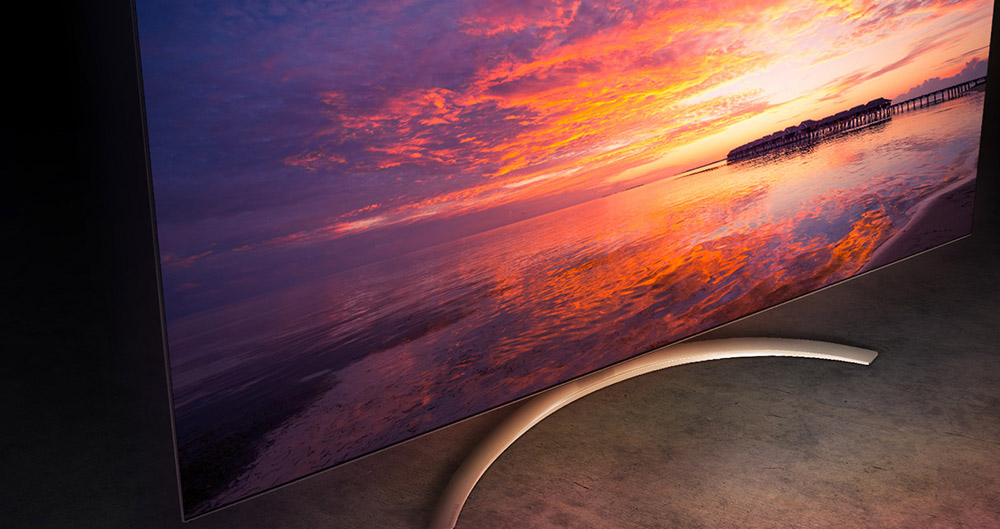
Design
Most of the NanoCell models come with similar designs so it’s not easy to distinguish each one of them as only a couple of them come with a bench type stand while everything else use the same crescent type of Y-stand. Looking the SM9000 reminded us a lot of the recently reviewed SM8600 when looking it from the front. The back has a different ports configuration so it’s more easy to spot the differences but everything else is very similar to each other.
The SM900 is relatively thin if you consider that we are talking about a Full Array backlit panel which adds to the overall thickness but nevertheless the TV has a pretty good look that will show nice both on a furniture but also on the wall. The top of the TV is a bit thinner with a curvy design while the rest of the body keeps a uniform look. It comes with a nice metal border while the distance between the border and the pixels is very small making it look very nice in our eyes.
All connections are located on the back right side separated in two groups with sideways and backward ports available. The back side of the TV has a nice brushed texture that we have seen in many NanoCell models and looks very pleasing.

The SM9000 uses a crescent design for it’s Y-shaped stand which we see in most NanoCell models this year. It looks very nice giving the TV a more premium look but it can make the TV wobble a little if pushed. It does not run the risk of falling but it can shake a bit more than what we would like. Cable management we get is pretty basic but at least you can gather all cables at the back of the stand leg in order to hide them from plain view.
The included remote is the one we have seen before and seems to be the same Magic Remote we will be getting in all 2019 models (MR19). There are not much differences between this and previous years but this is not a bad thing as we think it’s an already great remote to use. Of course it’s highlight feature is the mouse pointer function which is really unique and can help you input text much easier than a simpler remote. Also the ability to communicate with the TV through Bluetooth makes issuing commands much easier as there is no need for directly pointing it to the TV.

This year’s Magic Remote has been improved by having the ability to work as a universal remote also. By having a built-in IR blaster you can issue commands to other devices even if they don’t support HDMI-CEC. As such using one remote for all your devices can dramatically reduce the number of remotes that may sit around your home theater.
A very nice TV both in looks and build quality. The SM9000 looks more premium than it is and comes with the kind of quality that we are used from LG. No complaints here.
Video Quality
Processor technology used
As with all NanoCells, the SM9000 comes equipped with the same processor called a7 Gen 2 intelligent processor that is a step down from the a9 variant that is used on the top OLED models but comes with various improvements compared to last year’s already remarkable a7 processor.
But how can you improve on a processor that was already so good? It seems that the a7 Gen 2 adds AI into the mix this year. What the Gen 2 variant does is to analyze the content being displayed and make automatic optimizations for noise, sharpness and clarity in order to offer a better overall result. It also has the ability to analyze the environment with the use of the built-in light sensor and make adjustments to the brightness in order to offer the best picture possible no matter the viewing position.
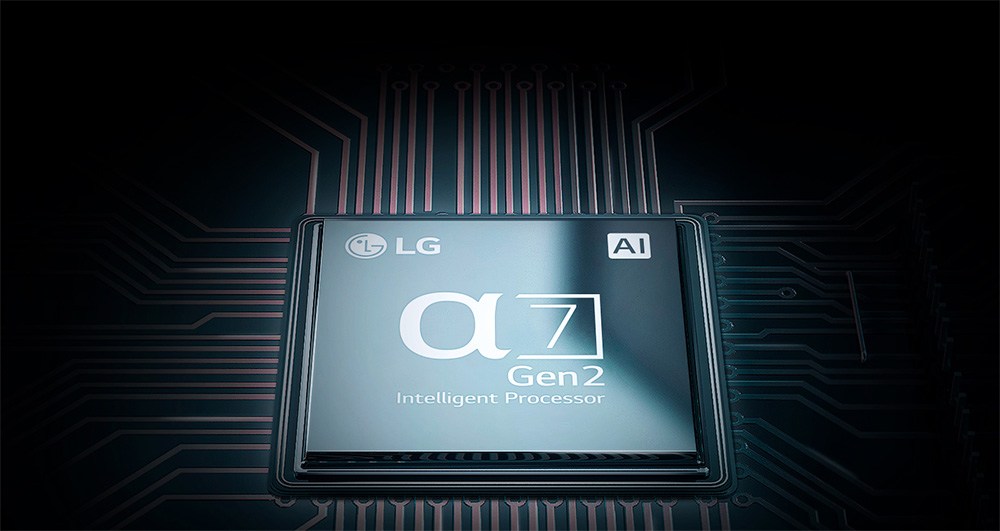
But AI optimizations made by the a7 Gen 2 processor are not only used to improve image performance but audio as well. When you are viewing any kind of content the SM9000 has the ability to analyze it’s audio and optimize the TV’s sound for the best result possible. Also sitting at the sweet spot is not necessary anymore as the TV recognizes your viewing position and calibrate it’s sound so you can have the best result where you sit. Lastly the TV can up-mix any kind of stereo audio to virtual 5.1 surround audio.
As you can understand the a7 Gen 2 processor takes everything good we saw last year and by adding AI functions it tries to improves things even more showing how much LG is pushing technology forward.
Lighting technology used
One of the major elements of how good a LED LCD TV can perform is the kind of backlight system it comes with. There are two variations right now with one having the LEDs behind the panel while the other have them on the edges. The one that have them on the back is the best as it can provide better precision and more light control compared to Edge LED. A few years ago a Full Array with Local Dimming (FALD) system was used only on the top flagships but this is the good thing with technology as we begin to see even middle tier TVs come with some kind of FALD system which provides so much more benefits and better image quality.

As such we find the LG SM9000 featuring a FALD system and in fact this is the lowest TV model that you will find this system (along with SM8500 in Europe) as the next model in the lineup, the SM8600, features an Edge LED system instead and as a result this has a major impact on light and image quality overall. So if you are looking for a low cost TV but having a FALD system is a must for you, this is as low as you can go.
The model we are testing is the 65″ variant which comes with the simple FALD system which means less dimming zones available and this results in what is called blooming which creates bright halos around bright looking objects when viewed on a dark background. And with the SM9000 this effect is very obvious but even like this we still prefer this than any kind of Edge LED system. We should point out that the 75″ and 86″ variants use the FALD Pro system which means more dimming zones while the smaller sizes only get the simpler FALD system.
Brightness / Contrast
One of the major weaknesses of the SM8600 was it’s brightness and here things seem much better. The use of a Full Array backlight may also have something to do with this but nevertheless we are pleased to see the SM9000 performing much better in this regard. Measurements were taken with the Cinema picture mode, Medium Local Dimming, max backlight and Warm 2 temperature.
The SDR brightness we got over a 10% window was 395 nits which may not be very high but is more than adequate for any kind of SDR content. On the other hand measuring HDR brightness over a 10% window gave us 1155 nits which is very good and enough to display very bright images that HDR demands.
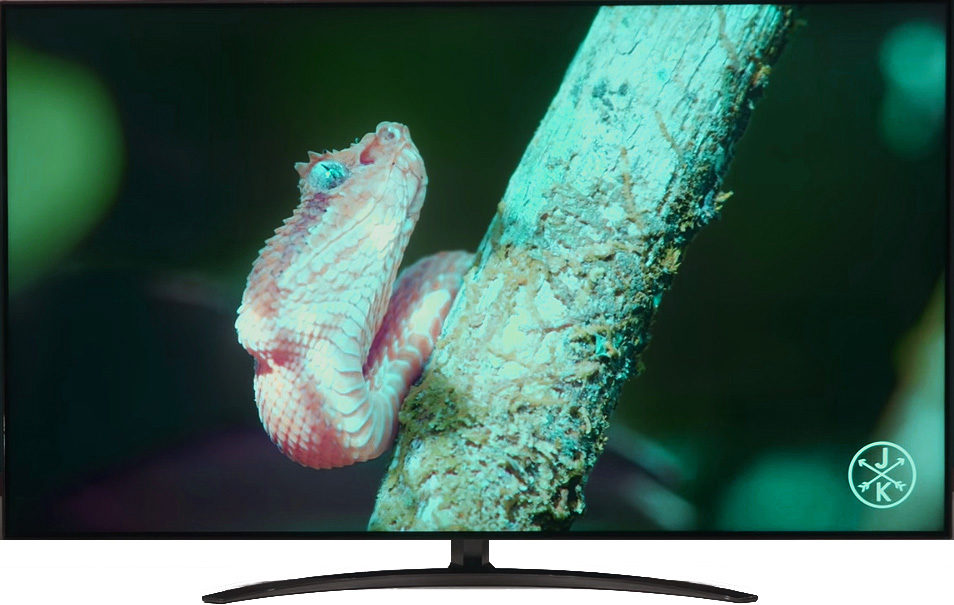
Contrast on the other hand was average and this was to be expected from an IPS panel and as a result blacks are not so deep and look more greyish than deep blacks. If you plan to use this TV on a completely dark environment this problem shows more so it is preferable to have some dim light that will help greatly to minimize this weakness.
Viewing angles
The SM9000 comes with an IPS panel that we see in all the NonoCell series. IPS panels in general can provide better viewing angles than typical VA panels that we mostly see in Samsung TVs. IPS panels of course cannot reach the extreme angles we see with OLED but nevertheless the results are good even at more than usual viewing positions. Trying out the SM9000 we could say that the image kept it’s integrity up to about 30 degrees of angle. Moving further away from the center we started seeing major downgrade in colors, brightness and black integrity.
HDR support
When it comes to HDR most of the NanoCells except the very low models in the series offer the same kind of support. As such in the SM9000 we get the usual set with HDR10 that is the absolute basic that needs to be supported for UHD playback, HLG that is the HDR used a lot for broadcasting while we also find Dolby’s more advanced version that supports dynamic metadata and is called Dolby Vision.
No surprises here as the new HDR10+ is absent and this was to be expected with it being heavily backed by Samsung while LG prefers to stay firmly aboard the Dolby Vision bandwagon. Of course since HDR10+ doesn’t need any special hardware we wouldn’t be surprised to see LG backing it up at some point in the future especially if it gains enough traction to become mainstream.
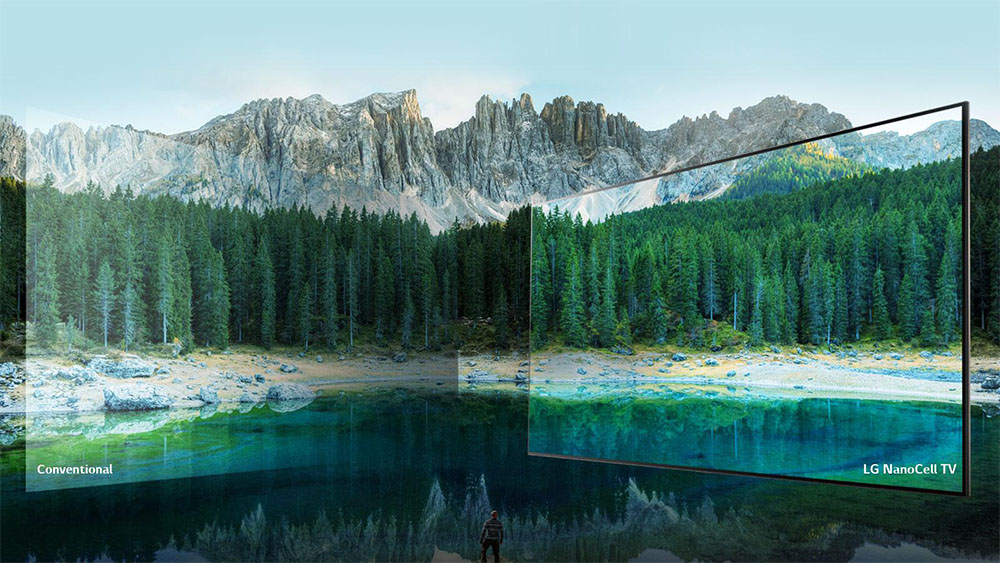
Color coverage
As the naming indicates the SM9000 is equipped with a special layer called NanoCell in order to improve the colors on screen. It’s a similar technology to Quantum Dot that Samsung is using in their QLED series and similar to the previous Super UHD that LG had released the previous years. It seems that marketing dictated a name change as NanoCell sounds more catchy and is more in line to Quantum Dot. But in essence it’s the same thing and what this layer does is to absorb unwanted light in order to boost the purity of red and green on screen resulting in more vivid and lifelike colors.
Onto our test now the SM9000 seems to perform similarly, even slightly better, than last year’s SK9000. As such measuring the DCI-P3 color space we get a coverage of 93% while on the wider REC.2020 color space we get a coverage of 71%. Very good results from this NanoCell model as the numbers indicate a slight improvement over last year even if it’s only by a small margin.

Motion performance
Motion performance on the SM9000 was pretty solid and offers the standard features we get in similar TVs in this price range. This one here supports Motion Interpolation as well as Black Frame Insertion (BFI). With Motion interpolation we were able to smooth out the motion of the SM9000 enough to remove most blur from fast camera movements but you should not use very high settings otherwise you will get the familiar “Soap Opera Effect”.
We also tried the BFI feature that inserts a black frame between two individual frames and we got pretty good results. Unfortunately this feature lowers brightness as well as creating visible flickering some times. So it is a give and take situation where motion is much better and smooth but brightness takes a hit while flickering can be a bothering, even if not always visible, side effect.
Coming equipped with HDMI 2.1 ports means that we get all the goodies that come with this new version and as such we also get Variable Refresh Rate (VRR) if you connect hardware that supports it. Also it’s worth mentioning that in early 2020 LG released a firmware update that enables NVIDIA’s G-Sync.
Input lag
When it comes to input lag we have been very impressed with 2019 models from LG so far and the SM9000 continues this trend. With the Game mode enabled we measured input lag hovering at the 14.5ms mark which is incredible and very similar to what we had measured during our SM8600 testing which shows how much LG has improved this feature even in the NanoCell series which is supposed to be the more affordable middle tier series for this year.

We like to try some Call of Duty WW2 during this part of our testing so we connected our PS4 and went through a few parts only to get smooth reactions without any noticeable delays even when we are talking about such fast action oriented games. Input lag seemed similar in both 1080p or 4K resolutions so results were pretty consistent across the board with or without HDR content.
Lastly with the inclusion of HDMI 2.1 in the SM9000 means we also get Auto Low Latency Mode (ALLM) and if you have equipment that supports this same feature you can use it when connected to this TV.
Image quality impressions
We liked the general performance we got from the LG SM9000. The TV was able to display very sharp images in 4K resolution but also was great at upscaling lower resolution content with very good results. It comes with a FALD system for better light control, color coverage was great, viewing angles were very good considering we are talking about an LCD panel while input lag was extremely low which is characteristic of all 2019 models we have tested so far. HDR was also more than average and the TV was able to display very bright images when needed.
On the downsides we find the average contrast we got here with blacks not being very deep while the low number of dimming zones would result in light blooming making halos appear around bright objects again dark backgrounds. Local Dimming performance was also not very good as it was a bit slow to react to changes of light resulting in ghosting.

In total we would say that the major strengths of the SM9000 are it’s very good display of colors and the inclusion of a FALD system that greatly improves any LED LCD performance. For this price we could not ask for more.
Audio Quality
Checking the audio capabilities of the SM9000 we get a pretty standard and familiar performance as there is so much you can do with the included audio system. This TV comes equipped with a 2.2 channels system with a total of 40 watts power. Having a bit more space due to the included FALD system the down-firing speakers do the best they can in order to offer plenty of volume that is more than adequate for casual viewing.
This year LG tried a lot to improve things in the audio department and it did so by including various features that are a result of the new a7 Gen 2 processor. One of the new features is the One Touch Sound Tuning which makes it’s appearance in all 2019 models we have reviewed so far and it’s a smart system that uses the remote’s microphone to analyze the audio from your sitting position and calibrates the audio settings in order to get the best possible outcome. Think of it like the audio calibration systems we see with AV receivers but a more simple version of it.
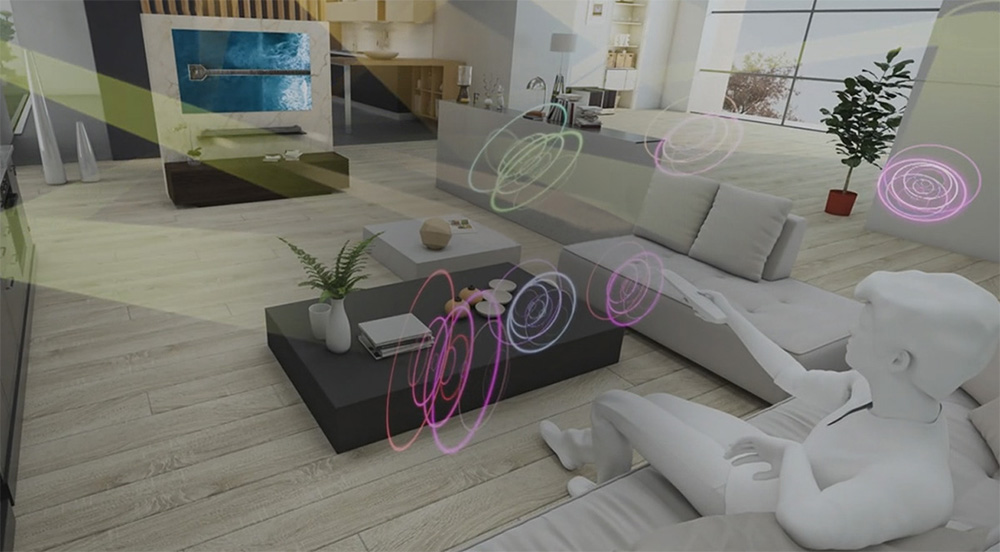
As we have mentioned above there is also up-mixing of 2.0 channels audio to virtual 5.1 surround sound in order to create a more encompassing experience. Dolby Atmos is also supported here but naturally the TV does not have the ability to show the real capabilities of the format as it lacks the necessary speakers to do so. Last but not least is the ability of the SM9000 to analyze the audio of the displayed content and make AI enhanced optimizations.
The a7 Gen 2 processor really tries to improve a rather limited 2.2 channels audio system and while we can hear little improvements in some instances we do recommend you to buy a dedicated surround system or at least a soundbar if you want to have any real immersive audio experience.
Inputs
In terms of physical ports most NanoCell models have more or less similar configuration and the only thing that changes is where these ports are placed. Typically all ports are placed at the back of the main body separated into 2 groups in different recesses in order to give you a bit more space with the cable connectors.
The one group has all ports looking sideways and here we find 4 HDMI inputs as well as 2 USB ports for external storage connections. As for the second group that looks backwards we get a composite input that only works with the included adapter, an RS-232C, an Optical Digital Audio output, an Ethernet port for wired connection to the internet, an additional USB port and of course the antenna/cable connector.
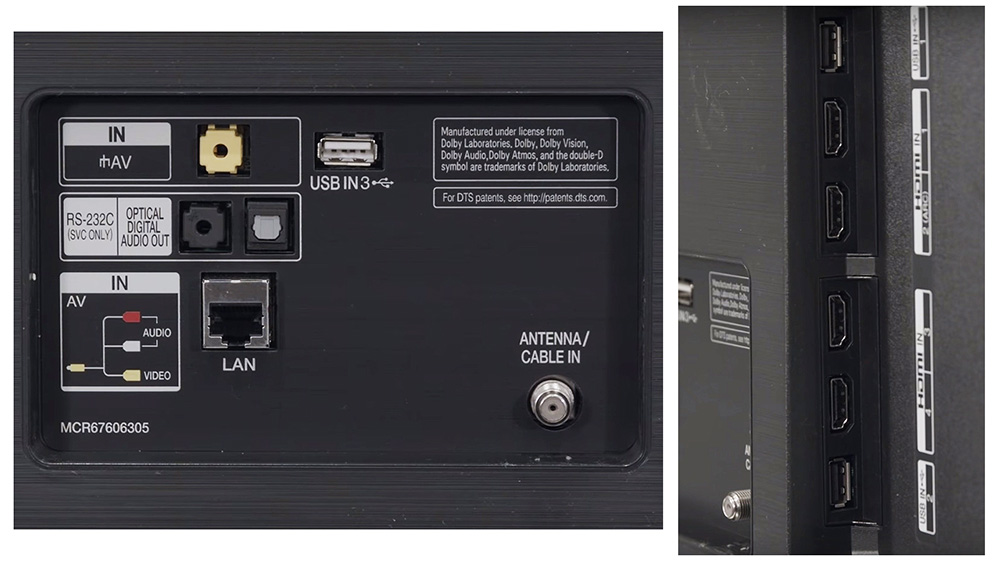
The SM9000 is the last model to get the new HDMI 2.1 ports with all four of them being the new version which means they support new features like Variable Frame Rate (VRR) while HDMI 2 also supports the new eARC in order to pass Dolby Atmos to an external device like a soundbar. Unfortunately for one more year we are stuck with USB 2.0 which is more old than we would like to remember and we cannot understand why manufacturers still insist on using such an old version when USB 3.0 is being used for so many years now.
OS, Apps and Features
Smart TV functionality is pretty much consistent across all models this year so having already experienced all the new as well as updated functions we knew what to expect from SM9000 during our testing. For the new models we find the updated webOS 4.5 that has minor changes compared to last year but if you have used any of the previous versions expect to see a more or less familiar environment.
And although the general layout is very similar to previous years one of the changes we see for 2019 is the inclusion of “AI Preview” which is an additional row that appears above the Launcher Bar and it provides various recommendations of content according to your viewing habits so in case you are a regular viewer of a specific show it can be very practical.

When it comes to the streaming capabilities of the SM9000 we get a plethora of options as the number of supported apps is really enormous and includes all the big names you would expect. Netflix, Amazon Prime Video, Youtube, Now TV, Rakuten, Demand 5, Hulu, Sling TV, Vudu, iTV, BBC iPlayer and Google Play Movies are some of the services you can find leaving none disappointed.
Due to so much content available it can be a bit troublesome to navigate around especially if you are using more than one service so LG has added an Intelligent Edit Function and what this does is to rearrange the applications according to how often you use them in order to prioritize those that you want the most. But customization does not stop there as the webOS give you a lot of freedom to customize everything the way you prefer the most.
We have already spent some time with the new interface and the new webOS 4.5 functions and we believe that LG has made nice small improvements to an already very solid platform. In all honesty no major changes were needed so the small visual improvements we find with the addition of AI Preview manage to make the use of it smoother and more practical.
Another new addition this year is the inclusion of Wisa support. Wisa wireless technology is a new feature with which you can connect wireless speakers that have built-in amplifiers to them directly to the SM9000. But while this feature is supported in order for it to work you will need to buy a separate dongle which is a bit of a shame. We didn’t have the chance to try this feature yet but we believe we will be able to do so soon in some of our future reviews and give you our impressions.

The TV offer all the possible ways of control you can imagine which is pretty much becoming a standard even to lower tier models. So if you find the remote control very old fashion and a thing of the past, LG has created the Remote App that you can download to your mobile device and control the TV through that. It may be a nice app offering a nice visual environment but it has certain limitations to it that hopefully LG will be able to fix in the future like it’s inability to input text in some services like Netflix or Youtube.
Of course nowadays we live in the age of voice control and most devices support this with the inclusion of both Amazon Alexa and Google Assistant support. As such the SM9000 can be controlled by both these services and the good thing is that you don’t need a separate device to accept your commands as the Magic Remote’s microphone is all you need to speak to. And what is even better is that your commands don’t stop only with controlling the TV as you can turn it into your smart hub by issuing commands to all your smart devices you have connected to your local network.
LG has also promised the inclusion of Airplay 2 and Homekit from Apple with a future update that we expect sometime during 2019 but there is no exact date when we will be seeing this. With Airplay 2 the SM9000 will offer multi-room capabilities by connecting various Airplay devices in your other rooms as well as adding further streaming capabilities that will let you stream content from your Apple devices to your TV.

Final Thoughts
Finishing our SM9000 testing we feel that this model offers a great balance of features with pretty good performance and it seems like it will be the ideal choice for many people. Image performance is great all things considered with the a7 Gen 2 processor adding AI functionality in order to improve both image and sound quality. The included NanoCell layer offers improved colors reproduction while the Full Array with Local Dimming system in this model offers better and more precise light control which makes a huge difference compared to other Edge LED systems.
This model also has very good viewing angles due to the included IPS panel while input lag is extremely low making it perfect for any gamer. As far as smart features and TV platform is concerned the SM9000 comes with the latest webOS which offer amazing functionality and a huge array of features and streaming services that will definitely please even the most demanding users.

As for the things that we didn’t like we can say that contrast leaves a lot to be desired as blacks appear more greyish especially if you are looking at the TV in a completely dark environment. Also the low number of dimming zones available create blooming with visible halos around very bright objects that are displayed against dark background. Also the cable management is very basic and we definitely miss Samsung’s One Connect Box while sound even with the AI improvements that LG added this year is still average and offers only very basic performance. If you want anything better a soundbar or dedicated surround system must be considered a must.
In total the LG SM9000 manages to offer very solid performance at a price that we believe is very affordable for most and for this reason we believe that it will be one of the most popular NanoCell models for 2019. LG has created another solid entry in their 2019 lineup and if you want a TV that has very good performance but your budget cannot go to higher OLED levels then the LG SM9000 is the ideal one for you.
For more reviews you can check our dedicated 4K LED LCD TV reviews list or even look at our Product Reviews Table where you can find the brand and specific product you are looking for.
Cheapest Places to Buy :
*We are a reader-supported website. When you buy through links on our site, we may earn a small affiliate commission at no extra cost to you. Home Media Entertainment does not accept money for reviews.*
I like the design of this LG nano cell TV, and you have made a very informative review.
I am quite disappointed that for such a beautiful 4K TV, the sound is not at its best. Can I connect it to a speaker? To improve the sound quality I mean. But the other functions are just amazing.
But I think just for the sheer amount of smart functions, this TV is a good option.
Yes this TV can be connected to a soundbar if you want to have better sound with the use of the optical digital output port but also when Airplay 2 will be available you will be able to connect it with Airplay 2 certified wireless speakers. Lastly it is Wisa ready which means you can connect it to other Wisa enabled speakers/ As you see plenty of options to choose from.
Very nice review, you certainly put a lot of effort into it. I’m currently considering to use a Screen for a small classroom (instead of an outdated beamer) and I like the HDMI 2.1 features. However for use with a laptop and presentation software the ‘average contrast’ comment worries me a bit. Did you test it as a computer monitor and if so any thoughts on that?
Although I don’t know what specifically you want to present with this TV I can assure you that for general purpose presentations it will be just fine. We haven’t tried connecting it to a computer but I don’t see the reason why it shouldn’t show everything good. As for contrast as I said it is average but it all depends on what you want to show on it.
The SM9000 is a beautiful one and your review helped me decide that my new television should be this one over about 4 others that I have been looking at. The features, the screen, the size, and even the design are very attractive. Even the price is within my budget on this.
The Magic Remote also has the mouse pointer function and from my own experience that is a great feature to have, I will use that often I have no doubt and the Bluetooth is preferable for me as well versus infrared connection as I have now (inconvenient at times as you have to point the controller directly at the TV).
I know that there may be higher ranges of TVs out there but the cost versus benefit is what I am looking at. For the number of hours I will be using the TV, the extra cost just does not make sense to get more than what comes with the SM9000. Thanks for the detailed review, you have made my purchase decision much easier.
I am glad our review was able to help you make up your mind Dave. If you need any further assistance let me know.
TVs have come a long way since the 60s. Then it was in black and white with only 2 channels and did not come on before 6am. Now we have all singing and dancing Android Smart TVs with hundreds of channels in brilliant color. What’s not to love? Thanks for sharing!
You are welcome Stella. Technology has come a long way the last 50 years. It only makes you wonder how TVs will be in the next 50 years to come!
Hey Stratos, great review!! Almost finalised the model after reading the review, but the blooming effect has made me cautious.
90% of time I watch TV in bright lighting conditions. Will it affect me? Does the tv lose the details in dark scenes even in good lighting conditions?
And is blooming more pronounced in SM9000 than in SM8600?
Hello Steve. The more bright the room the less visible the blooming will be. Keep in mind that blooming is visible only under very specific conditions. You need to have a relatively dark and mostly uniform background and a very bright object in order to see it. All these TVs that use more basic FALD systems have this problem. There is no way around it. The only way to combat this is to use more dimming zones which also makes the cost higher. So unless you can put more money to buy a TV with a better FALD system with more dimming zones don’t expect to find a model that will offer more if it has similar number of zones.
As for the SM8600, this uses an Edge LED light system which is inferior to the FALD system in the SM9000. So in comparison the SM9000 is much better.